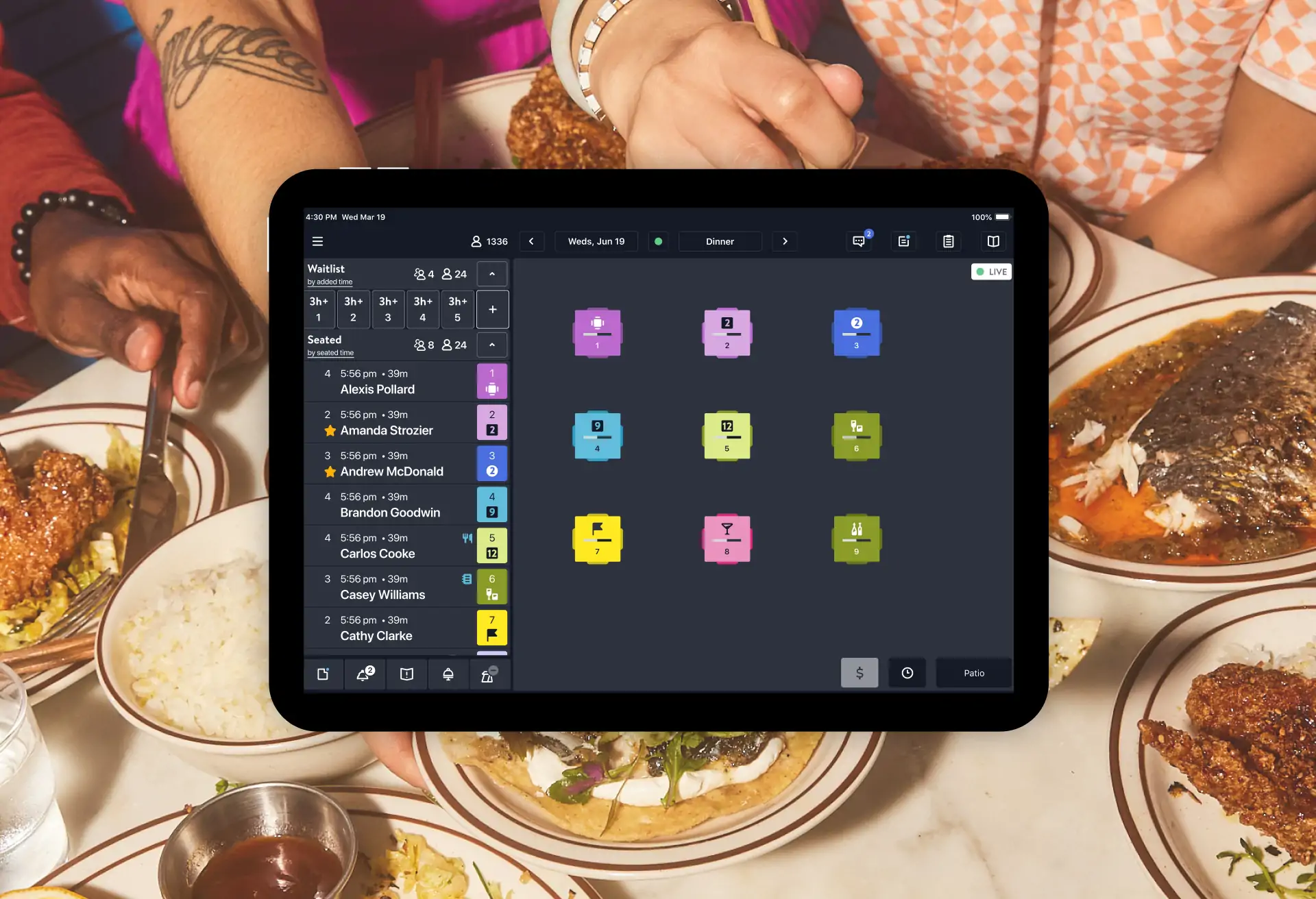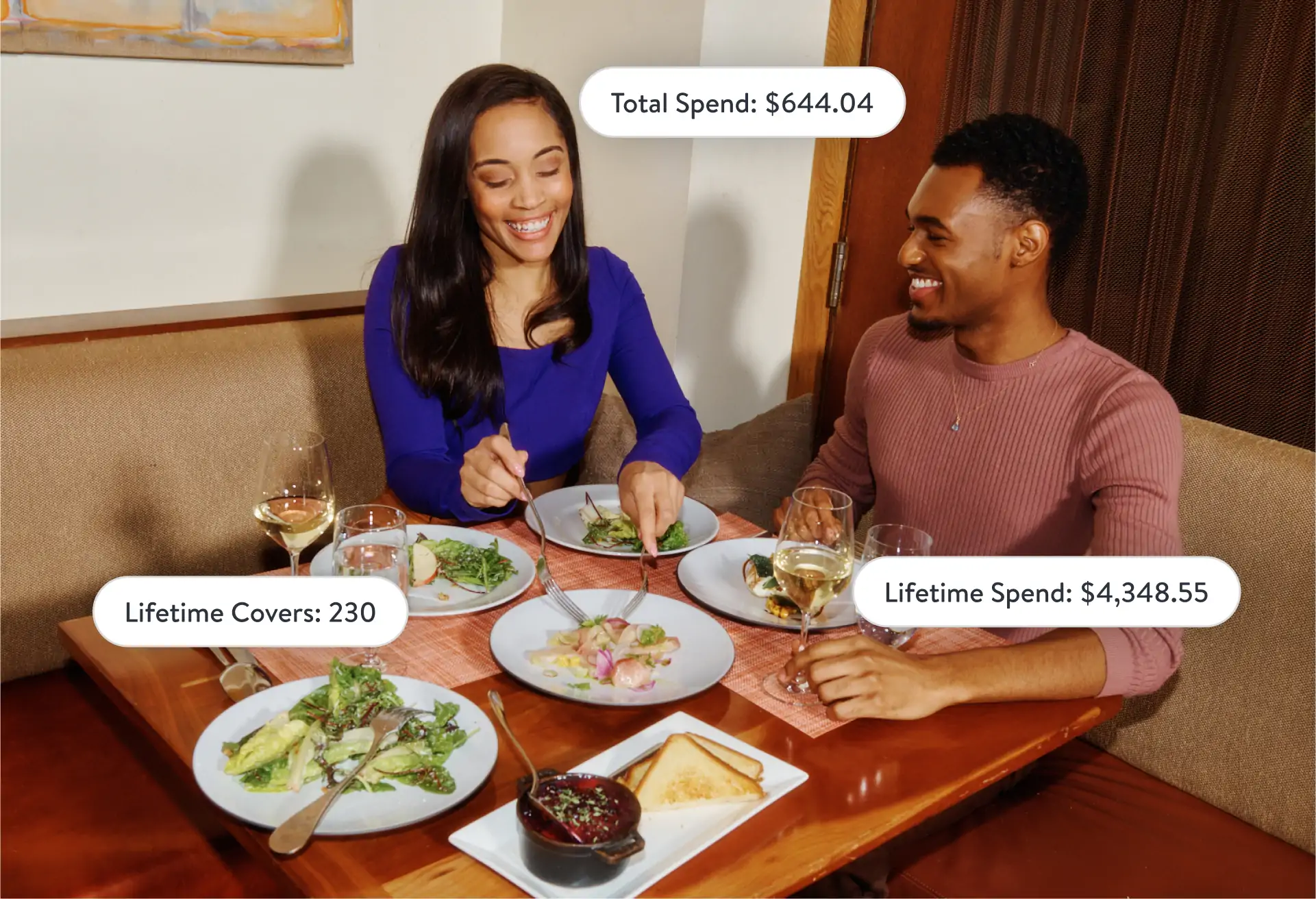Your table turnover rate is an important factor in understanding how your restaurant works. But improving it without compromising the guest experience can be challenging. How do you find the right balance between seating as many guests as possible while still maintaining a high level of service that provides the ‘wow’ factor?
That’s the purpose of this guide, which features seven ways to increase restaurant table turnover rate without sacrificing the guest experience.
1) Optimize your floor plan
The layout of your dining room plays a bigger role in table turnover than you might think. A well-designed floor plan naturally improves the flow, making it easier for staff to move between tables and for guests to navigate the space.
Start by grouping similar-sized tables together, as it’s easier to seat parties quickly and effectively. Create clear paths for servers and guests to move through the restaurant without bottlenecks or awkward corners. Look at using a mix of two-tops and four-tops that can be easily combined for larger parties. The result is more flexibility in accommodating different group sizes.
Consider the placement of your host stand, too. Position it where staff can easily see the entire dining room and manage seating more effectively. If possible, create a designated area for guests to wait that doesn’t interfere with server traffic or seated diners.
A smart layout helps seat guests faster, makes resetting tables more streamlined, and contributes to a more effective overall dining experience. Take time to analyze your current setup and don’t be afraid to experiment with different arrangements to find what works best for your space.

2) Streamline your menu
An overly complex menu can stop table turnover in its tracks. When guests spend too much time deciding what to order, or when the kitchen gets bogged down with complicated dishes, it slows down the entire dining process.
Try offering a balanced mix of quick-prep and more complex dishes. You can turn tables faster during busy periods while still catering to guests who want a more elaborate meal. Use clear, concise descriptions that help guests understand dishes easily without needing to ask a lot of questions.
Beyond that, consider creating a separate, streamlined menu for peak hours. For example, featuring your most popular and easiest-to-prepare items on the menu will help keep the kitchen running well when demand is highest. A focused menu offers more than just speed—it often leads to better quality. When your kitchen team can concentrate on perfecting a smaller number of dishes, the results are usually superior. Research shows that 75% of top quick-service restaurant chains that simplified their menus earned a higher sales bump compared to their peers.
3) More staff communication
When your team is in sync, everything moves smoother. Implementing strong communication systems improves your table turnover rate while enhancing the overall guest experience.
Start with a POS system that sends orders directly to the kitchen. It eliminates the need for servers to run back and forth, saving time and reducing errors in the process. Hold regular pre-shift meetings to discuss specials, potential issues, and any VIP reservations so everyone is on the same page before service begins.
Establish clear protocols for handling issues or special requests. When staff know the right things to do in various situations, they can resolve problems quickly without disrupting service for other guests.
And consider implementing a system for servers to communicate with each other during service. This could be as simple as subtle hand signals or as high-tech as earpieces. The goal is to allow staff to assist each other effortlessly so no table is neglected even during busy periods.
4) Train staff on efficiency
Your servers are on the front lines of managing table turnover. Investing in their training can pay huge dividends in terms of both efficiency and guest satisfaction.
Teach subtle techniques to guide guests through their meals without making them feel rushed. One way to do this might include suggesting a starter while guests look over the main menu or mentioning a popular dessert early in the meal to plant the seed for later.
Train staff to anticipate needs, such as refilling water glasses before they’re empty or clearing plates promptly when guests are finished. Taking a proactive approach keeps the meal moving as it should and shows guests they’re well cared for.
Show servers how to manage multiple tables at different stages of their meals. It’s a skill that allows them to provide attentive service to all their guests without getting overwhelmed or creating long waits.
Well-trained staff can significantly improve turnover without making guests feel rushed. They know how to read the room, understanding when a table wants a leisurely experience and when they’re ready to move on quickly.
5) Use technology wisely
The right technology helps when it comes to table turnover. Modern restaurant management tools offer ways to boost your operations without disrupting the guest experience.
OpenTable, for example, can help you manage seating more effectively and predict busy periods. Consequently, you can staff appropriately and prepare for rushes. Table management software can also track dining times, helping you identify bottlenecks in your service and adjust accordingly.
Look at integrating your Point of Sale (POS) system with OpenTable, as it allows you to set up automatic table status updates based on menu items ordered. Imagine a server punches in an entrée order—the table status updates to “Entree” without anyone lifting a finger.
Once set up, the system will automatically update table statuses as orders are fired to the kitchen. No more forgetting to update statuses during the dinner rush, thanks to your POS doing the heavy lifting for you.
Consider implementing mobile payment options to speed up the check-out process. Doing so can significantly reduce the time tables sit empty between parties, especially during busy periods.
Use guest data from your reservation system to personalize the dining experience. When you know a guest’s preferences or if they’re celebrating a special occasion, you can provide tailored service that enhances their experience while still maintaining efficient turnover.

6) Create a welcoming bar area
A comfortable, inviting bar area serves double duty in your restaurant: It’s a revenue generator and a smart way to manage wait times and strengthen your overall table turnover number.
Train your bartenders to engage waiting guests, keeping them updated on their table status. Not only does this keep diners happy, but it also helps seat them in a timely manner when their table is available.
Offer bar-only specials or a selection of quick bites. Hungry guests will feel more satisfied rather than growing frustrated at waiting for a table. It also provides an option for guests who want a faster dining experience, freeing up tables for those looking for a full meal.
Design your bar area to be comfortable for both seated and standing guests. Having this type of flexibility lets you accommodate more people during peak times and reduce the pressure on your dining room.
7) Implement smart pre-bussing
Nothing slows down turnover like a dining room full of dirty tables. Implementing an effective pre-bussing system makes a huge difference in how quickly you can seat new guests.
Train servers to remove unnecessary items throughout the meal discreetly, whether it’s clearing appetizer plates when the main course arrives or removing empty glasses as they’re replaced. The goal is to do this without disrupting the guests’ conversation or making them feel rushed.
Bussers should always be available during peak hours to assist servers to allow for faster table resets once guests leave. Use elegant bus tubs or trays that won’t disrupt the dining atmosphere if they need to be visible in the dining room.
Consider implementing a team service model where servers assist each other with bussing, as it can speed up the process during busy times. There’s also the added benefit of a team model fostering a sense of camaraderie among staff.
The goal isn’t to rush guests out the door as quickly as possible. Instead, it’s about finding the sweet spot between efficiency and hospitality. Train your staff to read guest cues—some want a quick bite, others a leisurely meal. The aim is to provide the experience each guest is looking for while maintaining fluid operations overall.
Finding the right balance
Putting these strategies in place means you’ll increase your table turnover rate while maintaining—and even enhancing—the quality of service your guests expect. It’s a delicate balance, but getting it right can significantly boost your restaurant’s success.




